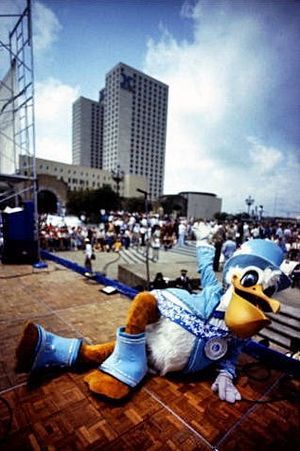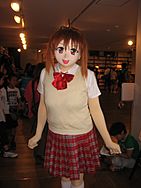Costumed performer facts for kids
A costumed performer or suit performer wears a costume that usually, (but not always) covers the performer's face, typically to represent a non-human character such as a mascot or cartoon character. These range from theme park "walk-around" or "meetable" characters, the mascots of corporations, schools, or sports teams to novelty act performers. Some costumes cover the performer's face especially those in theme parks.
Examples include sports mascots and performances as fantasy characters on children's television and in theme parks. Problems in suit performance include intense physical exertion, claustrophobia and hyperthermia.
Contents
In theme parks, international fairs, and festivals
Costumed performers are a major feature of amusement parks like Walt Disney Parks and Resorts, Universal Parks & Resorts, Sesame Place, Legoland, SeaWorld, Hershey Park, Six Flags, and Nickelodeon Universe, as well as many other large or small theme parks and fairs.
Costumed performers are intended to add to the fantasy experience by enabling visitors to encounter and interact with fictional characters, such as mascots for a company or organization. The characters are portrayed by employees in costume. Some of the costumes merely consist of clothing and makeup, while those for non-human characters generally conceal the performer entirely and include a full bodysuit, a head, and sometimes accessories or clothing on top of that. A longstanding policy in most well known theme parks is that the first category of characters, where the performer's face remains visible (usually "face" characters) are allowed to speak (usually on the basis of scripts carefully prepared in advance), while the second category of characters, where the face is covered (sometimes called "fur" characters) are not allowed to speak, although are allowed to make noises, and tend to communicate through pantomime.
A common occurrence, often involving "fur" characters, is that young children can feel particularly intimidated by the size of the costume. They can also be intimidated by the quick movements of more energetic characters, or by the character approaching them directly, so performers frequently slow down or kneel down when interacting with smaller children to let the child approach them.
For human characters based on a well-known media franchise that speak with visitors, theme park operators may prepare detailed scripts covering a variety of questions regularly asked by visitors, especially young children who have difficulty distinguishing between reality and fantasy. Performers cast in those roles are required to memorize and rehearse those scripts as part of their training, so they can learn their characters' backstories by heart and consistently respond in character to visitors.
At theme parks, particularly at busier ones, popular costumed performers are usually accompanied by one or more assistants (also called "handlers" or "spotters") in regular park uniforms, who handle customer service, security, and crowd control. This minimizes the necessity for performers to break character to deal with those kinds of issues. When a performer needs a break, they simply give a prearranged signal, and their handler may then assure patrons the character will be back momentarily, before guiding them back to a lounge or rest area for them to recuperate.
All theme park operators that present costumed performers enforce strict character performance regulations so that performers are never seen out of character by visitors. In the case of more elaborate costumes, they are never seen "with their head off". A related rule is that performers costumed as the same character (often so that the character in question is never absent for too long) are supposed to avoid being seen side by side by the public.
In Japan
The Japanese name for costumed performers is kigurumi (着ぐるみ). The name comes from the Japanese verb kiru (着る, to wear) and noun nuigurumi (ぬいぐるみ, stuffed toy). Japan's kawaii aesthetic means that mascots are commonly used for promotional purposes. These mascots are often constructed with an appearance that is more chibi than Western mascots, with a massive head that encompasses the performer's entire upper body and the arms low on the body. Other mascots more greatly resemble anime characters.
Animegao
Animegao (アニメ顔, anime face) is a type of kigurumi used to portray anime or cartoon characters. The face of the performer is fully covered with a stylized mask, and clothing similar to the character's typical attire is used. Animegao costumes are used both in professional stage shows and by cosplayers, sometimes called "dollers", who make custom masks of various characters. It is still a very minor part of the cosplay scene in Japan, though throughout the mid-2000s, it began attracting attention in other countries, including the United States, Canada, and various European states.
On television
Current shows featuring a costumed performer puppet include Big Bird of Sesame Street, Barney from Barney & Friends, and Bear of Bear in the Big Blue House. Less complicated costumed characters include Hip Hop Harry, Yo Gabba Gabba!, and Mack & Moxy.
Older examples include New Zoo Revue, H.R. Pufnstuf, Banana Splits, and British series Gophers!.
Unauthorized costume characters
In recent years, amateur performers wearing unauthorized, counterfeit costumes of various pop-culture characters have appeared in popular tourist destinations such as Hollywood Boulevard and Times Square. They usually pose for photos and collect (or, often, extort) tips from tourists. The 2007 documentary film Confessions of a Superhero focuses on costumed "superheroes" on the Hollywood Walk of Fame. Because they are not regulated or authorized, there have been many controversies and arrests involving costumed performers in Times Square.
Industry
The mascot industry is estimated at $5-million a year. Toronto, Canada, is one of the hubs in the industry, with six major firms headquartered out of the city. Knock-off costumes are commonly fabricated in Peru, where they're called botargas, as well as other South American countries and certain East Asian countries.
See also
 In Spanish: Kigurumi para niños
In Spanish: Kigurumi para niños



